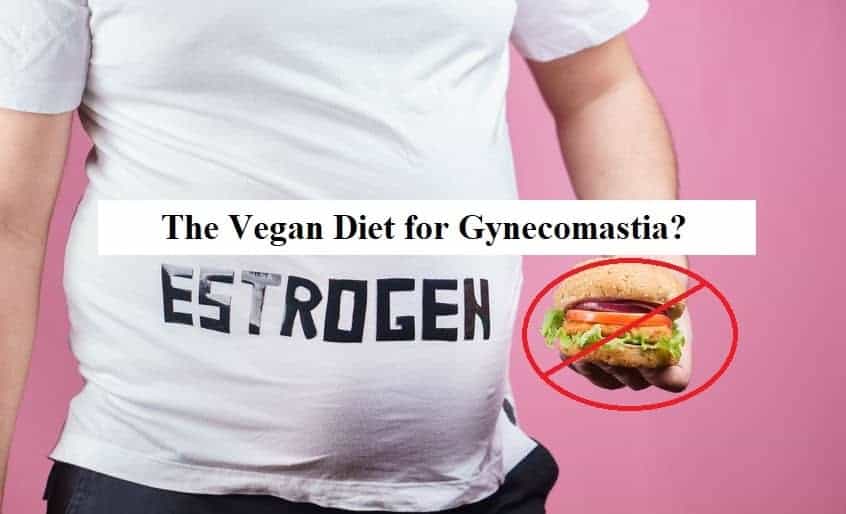Given the addition of the term “soy boy” to the urban dictionary, and the overhyped association of soy products with feminizing effects, I’m surprised at how often I’ve come across the question of whether or not a vegan diet can be beneficial for gynecomastia.
Unfortunately, no diet is known to reverse gynecomastia. The only known treatment for the reversal of the condition is surgical removal.1 Other treatments exist to stop the development of gyno in its tracks or lessen its development (hormone treatments, etc.) but such treatments fall short of reversing the condition.
However, the above applies to true gynecomastia—the glandular tissue. You’ll be happy to know that there is a sense in which a diet can help reverse gyno: it can help you reverse what’s known as pseudo-gynecomastia. If you’re interested, keep reading.
Gynecomastia Overview
Gynecomastia is the noticeable development of breast tissue in males.2 I stress the word noticeable, because while it’s the glandular tissue that’s growing beneath causing a protrusion, the growth of this tissue isn’t technically gyno unless it gives rise to a noticeable contour.
This is in part good news because diet—something you have control over—comes into play here.
There’s something called pseudogynecomastia, or pseudo gyno, that unlike true gyno (glandular tissue), is simply the deposition of fat in the breast area that accompanies gyno development—and thus contributes to the prominence of the contour.
The definition of pseudo gyno is “benign male breast enlargement due to excess subareolar fat.”3
I.e. if you manage to lose fat in this area, depending on the amount of gland tissue you have, the contour can become near unnoticeable. Which is all that matters.
According to an article published in Aesthetic Plastic Surgery, the author Venkata R states, “The patients seek flat chests irrespective of whether their breasts contain glands or fat.”4
Isn’t Pubertal Gyno Reversible? Therefore, Shouldn’t Adult Gyno Be?
Yes, it is true that pubertal gyno is reversible. During puberty, there’s often a relative imbalance between testosterone and estrogen. It’s transient, but can lead to gyno for a time, usually resolving by age 18 when adult estrogen/androgen ratios are achieved.5
But as mentioned above, there are two senses in which people talk about gyno.
- There’s the glandular tissue development, which is often used synonymously with gyno. This stuff is permanent.
- Then there’s the actual definition of gyno—the noticeable contour created by the glands, and/or fat deposition in the area.
Pubertal gyno is transient, and often doesn’t last long enough/isn’t severe enough to result in notable glandular development. Since it’s often fat, with little to no gland, it’s reversible.
Causes of Gynecomastia and Measures You Can Take
Fat Deposition in the Chest
As discussed above, this happens due to hormonal imbalances. Believe it or not, this fat will come off if you lose weight. You can’t spot-reduce by losing fat in the breast, specifically. However, by losing fat across your body your chest will also get smaller.
You may notice that the more chest fat you lose, the overall appearance of the contour will shrink in size, while the nipple becomes more pronounced–this is because you’re down to nothing but the gland tissue with a bit of fat over it.
Most normal everyday people will not notice anything at this point. If you’re in the fitness community you may find that bodybuilders often point out gyno, but that culture isn’t representative of the general population. They often point it out where it doesn’t even exist.
Anyway, I’d recommend losing down to about 10% body fat with a combination of calorie restriction and exercise. Working the muscles of the chest will also help provide a sculpted look that can help mask the nipple protrusion.
Finally, compression shirts are great at masking both pseudo and glandular gynecomastia. If you choose a good one, no one will be able to notice. You can wear them long-term or just until you manage to lose enough chest fat such that the gyno is no longer noticeable.
Also, if you plan to get surgery in the future (touched on below), having a nice compression shirt can help tide you over until you’re ready to take that step.
Puberty
As mentioned, hormones are out of whack for a time. This kind often resolves on its own.
Direct Exposure to Hormones—Estrogens, Androgens
- This is a common cause among bodybuilders and folks who administer exogenous hormones for sex changes—typically male-to-female transition hormone therapy.
- Marijuana—there’s long been a concern that chronic cannabis use could lead to gyno, but the concern may be unwarranted.6
- Some medications.
Not a lot to mention here. Obviously, don’t do anabolic steroids. Ask your doctor about the relationship of your medications, marijuana, and gynecomastia if you’re concerned.
It wouldn’t hurt to pay attention to any soreness or tenderness in the nipple area when exposed to new stimuli.
Rare Causes
Gynecomastia can be caused by genetic defects, tumors, and chronic liver disease.7
The appearance of enlarged breasts is a concern that affects many adolescent and adult males. While “gynecomastia” is frequently used as a blanket term when referring to this issue, the condition may actually qualify as “pseudogynecomastia” for certain individuals based on the anatomy of their abnormally large breasts.
Potentially Problematic Foods
While no diet can reverse gynecomastia, certain dietary components can influence estrogen levels in the body (discussed below)
While there’s no proven link between diet and gynecomastia, given that estrogen levels affect gyno outcomes, and diet affects estrogen levels, it might be prudent to avoid certain dietary practices which I’ll cover next.
Plant Based Diet and Gynecomastia
A Link Between Diet and Breast Cancer
This subject is covered thoroughly in 12 Ways the Vegan Diet May Help Prevent Breast Cancer. In reference to the study, Risk Factors for Male Breast Cancer, Hsing AW et al writes, “consumption of red meat was associated with an increased risk (of male breast cancer), and consumption of fruits and vegetables with a decreased risk, although the trends were not significant.”8

The study also states that while the etiology of male breast cancer is obscure, an excess risk has been associated with benign breast disease including gynecomastia.8
Significant or not, most behavioral models define perceived threat as the likelihood of some event occurring + severity of the event. I don’t know about you, but I consider both breast cancer and gynecomastia as pretty severe.
Body Fat
The link here should be obvious. How much you eat relative to what you burn determines whether you gain, maintain, or lose weight. As covered in the article on weight loss, plant-based diets do help achieve and maintain healthy body fat levels.
So, while short of liposuction there’s not much in the way of true spot reduction—though there is emerging technology, a topic for another time—losing weight will eventually result in losing fat from a desired area.
Obesity – A Unique Problem
This might seem redundant given the previous point was body fat. Aside from the body fat itself, obesity creates a hormonal environment that can be conducive to the partitioning of fat in male breasts, creating pseudo gyno.1
A Note on Phytoestrogens and Gynecomastia

Findings from a recent metanalysis along with studies published subsequently, demonstrate that neither isoflavone-rich soy products nor isoflavone supplements affect serum estrogen or testosterone levels in men, or exert feminizing effects.9,10
Also, aside from singular reports—gyno in men, and gender-related behavior changes in girls—after intake of soy products, no other data on such changes in humans as a consequence of soy consumption have been found.11,12
However, there are studies and case reports show an effect. All you can do is pay attention to how you as an individual respond to different foods.
Pay attention, and maybe keep a food journal and note if and when a certain food seems to bring about an unpleasant side effect. In this case, you’d be looking for changes in contour, breast tenderness, pain to the touch, etc.
Consider Surgery
That pretty much sums up the dietary factors. Keep in mind there’s always the surgical option. If you have glandular tissue you’d like to get rid of, you may want to consult a physician about getting that taken care of.
The surgery is often outpatient. If money is an issue, consider medical tourism. You can get procedures like this much cheaper in other countries, and often they’ll arrange everything—the initial consult, plane ticket, hotel stay, the works. Amazing times we live in.
Just make sure to google the physician’s name searching for “botched” surgeries to ensure you find someone who produces quality work.
Anyway, I guess that does it for now. See you in the next article.
References
- Ronald S, M.D. and Jason CM. Gynecomastia: Etiology, Diagnosis, and Treatment. https://www.ncbi.nlm.nih.gov/books/NBK279105/
- Select Gynecomastia: Medlineplus Medical Encyclopedia Image https://medlineplus.gov/ency/imagepages/9359.htm
- Cryolipolysis For Targeted Fat Reduction and Improved Appearance Of the Enlarged Male Breast. G Munavalli-R Panchaprateep -https://www.ncbi.nlm.nih.gov/pubmed/26218826
- B. Venkata R, How Important Is “Pseudogynecomastia”? Aesthetic Plast Surg 2011;35(4): 668–669. https://www.ncbi.nlm.nih.gov/pmc/articles/PMC3146708/
- Pubertal Gynecomastia. C Lazala-P Saenger – https://www.ncbi.nlm.nih.gov/pubmed/12014513
- Select Gynecomastia and Cannabis Smoking. A Nonassociation Among Us Army Soldiers. J Cates-J Pope – https://www.ncbi.nlm.nih.gov/pubmed/920892
- Ruth E Johnson, M. Hassan Murad. Gynecomastia: Pathophysiology, Evaluation, and Management. Mayo Clin Proc. 2009;84(11): 1010–1015.
- Select Risk Factors For Male Breast Cancer (united States). A Hsing-J McLaughlin-P Cocco-H Co-J Fraumeni – https://www.ncbi.nlm.nih.gov/pubmed/9684707
- Messina M, Messina V. The role of soy in vegetarian diets. Nutrients. 2010 Aug;2(8):855–888. doi: 10.3390/nu2080855. Available from: http://dx.doi.org/10.3390/nu2080855.
- Messina M, Melby MK, Kronenberg F, Kurzer MS, Taku K. Letters to the editor. Menopause. 2013 Mar;20(3):359–361. doi: 1097/GME.0b013e318284e64a.
- Adgent MA, Daniels JL, Edwards LJ, Siega-Riz AM, Rogan WJ. Early-life soy exposure and gender-role play behavior in children. Environ Health Perspect. 2011 Dec;119(12):1811–1816. doi: 10.1289/ehp.1103579. Available from: http://dx.doi.org/10.1289/ehp.1103579.
- Martinez J, Lewi JE. An unusual case of gynecomastia associated with soy product consumption. Endocr Pract. 2008 May-Jun;14(4):415–418. doi: 10.4158/EP.14.4.415. Available from: http://dx.doi.org/10.4158/EP.14.4.415.

